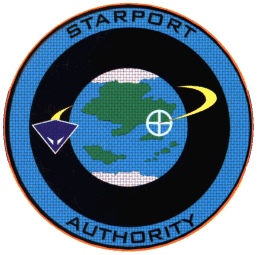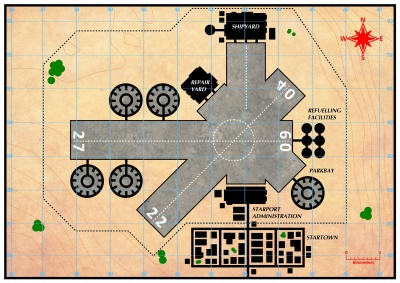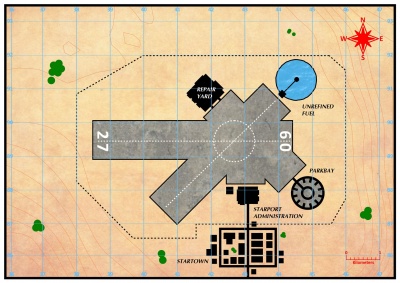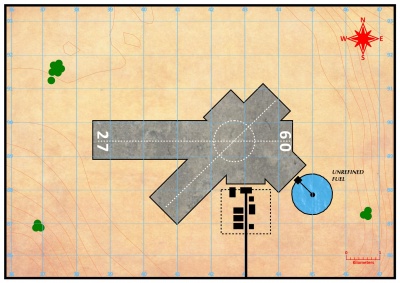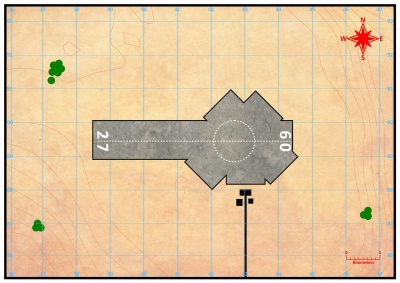Starport
Starports are established primarily to foster interstellar trade and commerce. [1] Starports generally have two components: a surface facility and an orbital facility. The surface facility includes cargo handling installations, a landing field, control towers, and other necessary areas. Surface starport components are frequently called Down (as in Regina Down Starport) or Downport. Orbital facilities are present (usually in stationary orbit above the surface component) to enable handling of unstreamlined ships, and to allow construction of heavy craft in orbit. The orbital component is often called Highport or Orbital (as in Regina Orbital Starport). Type D and E starports have no extensive orbital facilities, but usually have navigational satellites or similar equipment. Non-streamlined ships at these starports must be serviced by shuttles. Starports, being the primary point at which starships interact with a system, are usually the location for additional bases, such as scout bases, naval bases or other military installations, and for shipyards.[2]
The major traffic center in the system is the starport; all others are called spaceports. While it is possible for spaceports to accept starships, they are called (if only for convenience, and for terminology) spaceports. [3][4]
Starport classification
In the short form of the Universal World Profile ports are assigned a classification grade (A to E, and X) to the port facilities available in the system. This grade assigned to the port encompasses the services available in the port. The general classification are:
- Class A
- Excellent quality installation. Refined fuel available. Annual maintenance overhaul available. Shipyard capable of both starship and non-starship construction present.
- Class B
- Good quality installation. Refined fuel available. Annual maintenance overhaul available. Shipyard capable of constructing non-starships present.
- Class C
- Routine quality installation. Only unrefined fuel available. Reasonable repair facilities are present.
- Class D
- Poor quality installation. Only unrefined fuel available. No repair or shipyard facilities present.
- Class E
- Frontier installation. Essentially a bare spot of bedrock with no fuel, facilities, or bases present.
- Class X
- No starport. Class X starports are generally indicative of an interdiction. No provision is made for any starship landings and such landings are probably prohibited.
The Starport Authority (SPA) determines the port rating for all ports under its control which includes all the worlds within the Imperium and many worlds in the sectors around Imperial Space. The port classification ratings are reviewed frequently by the SPA with detailed reports issued regularly. For worlds outside of the Imperium the port classification are determined by an IISS review and detailed reports, where available, may be incomplete or out of date.
Critique of the classification
The starport classification compresses several important factors about port facilities into one classification code. It is possible for the starport to include some of the features of a higher quality port or lack the services of their classification. It is not clear how a classification is assigned in these cases. A frequently cited example is the availability (or lack thereof) of refined fuel. Another is the availability of repair or overhaul facilities.
Starport size
One major critique of the port classification is the size of the port, including the the potential number of other ships in the system seeking to use the starport and associated facilities, is not included. This lack of size neglects to mention if the port is capable of handling ships of specific size or type of ships. While the poorer quality of ports (D or E) generally have less traffic (hence smaller), and the higher quality ports (A or B) are larger, this isn't true in every case.
The SPA defines 5 sizes of ports
- Tiny
- The smallest of star ports. The port is run by fewer than a dozen employees, mostly on a part time basis; on a nearly barren world where the port's employees are most or all of the world's population, most of their time is spent on non-port activities such as surveying the world and growing food. The port is designed around seeing only a few ships per month with a maximum size of under 800 tons. The facilities defined by the classification are all available, but there will be few or no choices and service may be slow.
- Small
- Small ports are operated by fewer than 100 employees. The landing pads and operation facilities are sized for the small starships. Ship traffic will be a few ships per week, with some regular service each month.
- Medium
- These ports are the most common size of port, with between 100 and 10,000 employees. The port see regular daily traffic, centered around the medium sized starhips, and a dozens of smaller ships per day. Some medium ports also host the largest ships on a regular basis.
- Large
- These are found only along the major trade routes throughout the major empires of charted space. They see regular traffic of the largest of merchant liners, along with many other sizes of ships, and do so with up to a million employees.
- Very Large
- These are the largest ports found anywhere in charted space, they are correspondingly rare. They have over a million employees to handle the constant heavy traffic. Port this size have to be split into several locations.
Starport Operation
Who operates the port or ports on a world depend on the government running the world and allegiances of the world where the port is located.
Third Imperium ports
Within the Third Imperium, and in numerous client state and independent system near the Imperial borders, starports are run by the Starport Authority, as part of the Ministry of Commerce for the benefit of all member worlds.
In order to facilitate free trade, the Imperium requires the member worlds to grant a space to allow trade to take place. Imperial starports are part of the Imperium and within the starport boundaries, an Extrality (XT) line, Imperial law replaces all planetary law, or lack thereof. On Imperial or friendly worlds a simple fence may indicate the line. On worlds actively hostile to the Imperium, the line may be a heavily patrolled fortress wall. [5]
Each port is run by a port director assigned by the SPA who is given wide latitude to operate the facility as they see fit. The SPA expects the port to be financially independent relying on the port fees collected to cover all the expenses including salaries, maintenance, and any upgrades to the port.
Ports in the Aslan Hireate
Aslan ports are enclaves operated by a corporation on land leased from the local clan or clans. The corporation may be associated with the clan who owns the land, or an associated clan. In systems under multiple clan control, there may be more than one port. In general, these ports provide more facilities for vessels of allied clans than they do for outsiders. This can make traveling within the Hierate frustrating. [6]
Ports in the Hive Federation
The Hiver have a system similar to the Imperial one. The Federation Development Agency finds local Hiver nests to operate the starport and they have a level consistency and efficiency across the whole Federation. [6]
Ports in the Two Thousand Worlds
The Two Thousand Worlds has a quasi-governmental agency called Ghi'rurrikara !kuug'ri which oversees the construction of ports and and ensures they meet specific standards. The ports are otherwise run by the local herd. As with most things, the orbital ports are much larger than would be expected and the ground facilities are widely spread. There is rarely an extrality line, but a fence to prevent access to specific areas may be present. [6]
Ports in the Solomani Confederation
The Confederation does not have an overall agency for maintain the port. This is left to the individual members of the confederation. The Central Solomani government issues guidelines and protocols for ports, which are expected to be followed. This gives a much wider range of port operations than in the Imperium. [6]
Ports in the Vargr Extents
Private firms operate most Vargr ports, contracting with the local government. A world with a unified government the contract may be exclusive. On balkanized worlds there may be several competing facilities. While the local governments may ask for, or insist on, specific features (a good port enhances charisma), Vargr ports tend to be built, operated, and maintained as inexpensively as is practical to maximize returns. [6]
Port in the Zhodani Consulate
The Zhodani Consulate oversees the development of their worlds much more closely than the Imperium does, which includes the port. There are several different agencies responsible for different parts of the port. These agencies are expected to cooperate. The Zhodani prefers their ports to be self-sufficient and in that respect they operate much like the Imperial ports. [6]
Ports on the independent worlds
On worlds outside of the major empires, local governments own and operate the local port. In some cases the port is operated by a local corporation, leasing the port from the government. Like the Vargr, the government may insist on specific levels of service which may or may not be available. Like the Hireate, the availability of facilities and services depends upon local allegiances and outsiders may or may not receive the same level of service or have access to all the facilities.
Starport facilities
A starport is a collection of smaller facilities and services operated under the control of the authority operating the port. Starport facilities are distributed among one or more locations.
Destination ports
The standard ports are classified as destination ports where cargo and passengers reach their final destination. These ports are located near population centers or resources required by the populations.
- Downport
- The Downport consists of facilities located on the surface of a planet. Almost all ports have at least some ground component. Landing at the Downport requires craft capable of atmospheric flight and landing. Since some spacecraft lack this capability, it will limit traffic.
- Highport
- The Highport consists of facilities located in orbit around the world, one or more large Orbital Complexes. These stations are usually in stationary or geocentric orbit above the Downport to enable handling of unstreamlined ships, and to allow construction of heavy craft in orbit.
- Beltport
- A Beltport is the location of the starport in an Asteroid Belt system. In design it is between a Highport and a Downport. The advantages of this system have lead some worlds to convert a small planetary moon or move a medium asteroid into planetary orbit to serve as a orbital belt port.
- Subsurface port
- These are port set into or beneath the surface of a planet. This is common on asteroid (e.g. Belt ports), vacuum worlds, underwater ports on water worlds, and other hostile planets. [7]
Transit ports
Transit ports exist to facilitate cargo and passengers moving from destination to destination. Transit ports are located away from population centers. The starport work force is entirely imported from elsewhere making it more expensive to operate than normal ports.
- Trade port
- A Trade port looks like a typical port, but is in a low population system located on a major trade route. There are little cargo and few passengers to or from the world, but the port handles a large volume of ship traffic.
- Farport
- A Farport is an orbital complex located in deep space away from the inhabited planets. This may be a port in orbit around a fuel source like a Gas Giant or in a solar orbit far from the primary star.
- For Example, in systems with giant primary stars, or with multiple stars, access by ship may take an inconveniently long time (a week or more) to travel from the jump break-out to the mainworld. This is an ideal system for a Farport.
- In TL–17 or better empires, ships with Hop Drive will emerge 1000 diameters from the primary star. Farports are therefore situated at this point -- preferably 1000 diameters from a gas giant or ice-capped frozen world, for refueling convenience.
- Deep Space Station
- A deep space station is a starport or port facility located in deep space, outside of any star system. The Deep Space Station serves as a Jump Bridge, allowing ships to travel between two normally inaccessible systems.
Traffic Control
Traffic control manages the arriving and departing ships. They are intended to provide safety and smooth operation at the port via communications. Traffic around ports is generally restricted and controlled, and access to the air and space surrounding the port must be requested and granted.
Traffic control divides space around the port into zones; An Airspace Zone which extends 20 kilometers around the port. An orbital zone which extends from planetary surface to 10 diameters. A transition zone which extends to 100 diameters. And an advisory zone that extends to the outer limits of the system, generally around 100AU or orbit 11. [8]
Traffic control procedures are of two types. Procedural control relies on the craft adhering to published procedures using advisories and information from port control.[9] The ship captain and pilot plot their course to their destination with the advice of starport traffic control. Positive Control relies on the port control to positively identify and track all craft and issue specific directives for operation. [8]. All course plotting is performed by traffic control and craft pilot are expected to follow the directions. Where the traffic control switches from procedural to positive control depends upon the classification of the port and volume of traffic.
Shipbuilding & Overhaul Facilities
Shipbuilding is often associated with ports, with starships being associated with starports rather than spaceports. Ports with shipbuilding facilities will also have repair and maintenance capabilities, although there is no guarantee on availability, particularly to offworlders. Jump drive maintenance and repair may or may not be available at a spaceport.
Outmoded ships may be improved by refitting; obsolete systems are replaced by newer models. All refitting must be done at an A or B starport, and jump drives may be refitted only at class A starports. Refitting involves the complete removal of an old system and the installation of a new one; for instance, if a power plant is refitted, the entire power plant is removed and a new one put in its place. Refitting takes up shipyard capacity equal to the refitting ship's tonnage. Changes in power plant, maneuver drive, or jump drive are major changes.
Full repair may be done at any A or B starport, but jump drive repairs require double cost and time at B starports, and no starport may repair a ship system of higher tech level than the starport's tech level. Repairs require shipyard capacity equal to the ship's tonnage.
Berthing
Berths are where ships land to transfer cargo, passengers, and other sundries that make trade happen. The SPA defines four sizes of ships; 100 tons, 800 tons, 5000 tons, and 20,000 tons, and designs the ports to have a 4-1 ratio between each size. All berths provide a power supply and life support hookups for ship operation while on the surface.
A Downport a berthing spot will be a large, walled open space. Some will offer retractable roofs, often no more than the equivalent of canvas. A few of these berths have no walls, offering only a roof. At the poorest ports, the berthing is simply an open space on the ground. Each berthing spot is connected to the main terminal by a roadway (for the cargo traffic) and a slide way or grav vehicle transport (for passengers).
At a Highport berthing for the smaller ships will be space dock hangers, which can be closed from space for access. Larger ships will attach using external grapples to ensure stable connections.
The final option is orbital berths, where the ship takes up an orbit next to the high port, or at least in a standard orbit, with cargo and passengers are ferried to and from the ship by small craft. This may occur when traffic unexpected overwhelms the port design capacity.
Other Facilities
- Transportation Terminal
- Large ports usually have transportation terminals associated with them tying them into planetary transportation networks. If the terminal is not co-located with the port, there will be shuttle services connecting them. With smaller ports the availability and frequency will be lower. A small port may only offer services during restrict hours. A frontier port may not offer any scheduled services, but ad-hoc and unscheduled services may be available.
- Warehousing
- Warehousing facilities permit rental of space to house cargoes while awaiting sale or transfer to an outbound vessel.[10] Warehousing in orbits may be limited and expensive if storage in a secure space with life support, but is relatively cheap if it involves being parked and monitored in orbit. Warehousing is more likely to be available on the surface, but again the price may depend on local conditions and storage requirements. Availability again relates to the size of the port. Larger ports have more traffic and normally have larger warehousing needs and resources.
- Associated Military & Paramilitary Bases
- Starports, being the primary point at which starships interact with a system, are usually the location for additional bases, such as scout bases, naval bases or other military installations, and for shipyards. In those cases, a portion of the port is normally set aside for military services and personnel.
- Star Town
- Startown is a generic term for an area - usually just outside the XT line - occupied by cheap hotels, grimy taverns, and even less savory places, serving the people who are not quite part of either the local community or the port, but associate with both.[11] For most Imperial ports, the town exists outside the XT line, or a few kilometers down the road. For other ports, the town may be within the starport grounds or straddling the port border.
Services
- Security
- Small and remote ports will not necessarily have organic security, and will usually rely on local law enforcement. If guards are needed, they will most likely need to be hired from local personnel. Access to all but the smallest ports is going to be monitored and people will be questioned if there doesn't appear to be an obvious reason for their presence. Expect more extensive security and monitoring at larger ports, and that access to portions of any port will be restricted. On worlds with ongoing problems (e.g. an Amber Zone world) security may be provided by Imperial Marines or the local equivalent.
- Emergency Services
- The primary port emergency service are the crash, fire, and rescue (CFR) service, for dealing with emergencies. This would include potentially hazardous materials being spilled or released.
- Medical Services
- Every port has at least a first aid station. Class C or better ports will have a doctor or nurse on station at all times with a dedicated office for medical treatments.
- Search and Rescue (SAR) Services
- Major ports have SAR capabilities but the extent of those capabilities is proportionally related to the size of the port. Major ports will have capabilities to operate system wide. Medium sized ports will have more limited capabilities which may only be available within a certain range of the port. Small ports' SAR capabilities will be even more limited. It may be that they only monitor operations via satellite and standard communications and refer information to local authorities for action. Primitive facilities may have no SAR capabilities or they may be restricted to the port itself.
- Life Support Capabilities
- Life support (supplies, air, water, food, and other items) is always available at class A, B, and C ports, but is limited at other locations. The availability at smaller ports is usually determined by the UWP of the world. For example water is going to be available on world with significant water, but food may not be. Ships should stock up on supplies when available rather then depend of availability at smaller ports.
- Brokerage
- Brokerage also usually depends on size but there are exceptions. Any port with a substantial commercial component will have brokers. Therefore it may be difficult or impossible to find a broker on a frontier world. Fortunately, due to the availability of communication, brokers, if available, are not restricted to orbital facilities.
- Shuttle Services
- Ports with orbital facilities will normally provide shuttle services to a ground installation. Large ground facilities will also normally provide shuttle service to orbiting ships. With smaller facilities, private shuttle service may be available. There may also be ground shuttle services connecting ground facilities to transportation hubs, if they are not co-located the the port.
- Travellers' Aid Society (TAS)
- TAS facilities are not available at all ports but are common in class A, B, and C ports. Even when TAS facilities are available, the types of amenities vary.
- Lodging & Entertainment
- Large ports will have restaurants, hotels, casinos, bars, and other facilities associated with them. Smaller ports will normally host at least a restaurant and have some lodging available in close proximity to the port. At primitive and frontier locations anything goes.
- Fuel
- Usually unrefined fuel is available at most ports where the hydrosphere rating is one or above. Where it is not, expect prices to be greatly elevated due to the fuel transportation costs from gas giants, other planets, or ice asteroids. Often on worlds with available water fuel costs may be less at ground facilities than at the orbital ones.
- Naval Architect
- An office or company to perform ship design. May also be required for any upgrades to ships to ensure the new changes won't cause damage to the ship.
Starport in a time of war
A world’s starport is usually the first objective of an invader. The starport usually is close to several other nexuses, and controlling it gives access to the world’s traffic-control systems, which can at least make an attempt to track objects in orbit.[12]
In addition access to the other facilities of the port like refueling capabilities and the shipyard, are important reasons to capture the port intact. It also gives reason it would be the most heavily defended part of any world.
During the Rebellion, Starports became a major target of the Black War efforts on both sides. Standing head-and shoulders above the other reasons for the decline of starports is Lucan's scorched earth policy regarding his rivals' interstellar resources. If he could not retain an important resource, then it must be destroyed to deny it to the enemy. [13]
Starport construction
Worlds with better starports will benefit significantly more from trade than will those worlds with lesser starports. Worlds with starports of less than C do not really benefit from interstellar trade, other than the availability of resources on the interstellar market. Worlds with D class starports only begin to benefit with three or more trade partners worlds, and even then it only benefits marginally. Worlds with E class starports only benefit from trade in empires comprising hundreds of worlds. Of course, worlds with no starport never benefit from interstellar trade. [14]
There are a number of reasons that an interstellar state would need to improve the quality of their member worlds' starports. Starport type is a limit on Tech Level growth. Higher class starports can increase the economic growth through trade. Finally, only certain starport classes can produce certain types of military units needed for defense. Therefore, at key points during the system's growth, there will be a desire to upgrade a system's starport.[15]
The larger challenge of building a port, though the better class of port can be very expensive to build, is having the port traffic to maintain it. The SPA, and the equivalent organizations in other empires, desire the ports to be self sufficient. Meaning the budget to maintain facilities, pay salaries of the workers, and so on needs to come from various port fees. While a few worlds have attempted the "build it and they will come" approach, very few of these succeed.
Image Repository
See also
Starport facilites
- Starport Types
- Facilities
- Services
Universal world profile
- Main world
- Hex Number
- Universal World Profile
- Starport (Sp)
- Planetary Size (S)
- Atmosphere (A)
- Hydrosphere (H)
- Population (P)
- Government (G)
- Law Level (L)
- Tech Level (TL)
- Trade classification & Sophont Codes
- Importance Extension (Ix)
- Economic Extension (Ex)
- Cultural Extension (Cx)
- Nobility
- Bases
- Travel Zone
- PBG - Population, Belts, Giants
- P: Population Multiplier
- B: Belts
- G: Gas Giants
- Worlds
- Allegiance Code
- Stellar Data
- COG Sequence
References & Contributors (Sources)
| This page uses content from Wikipedia. The original article was at Airport. The list of authors can be seen in the page history. The text of Wikipedia is available under the Commons Attribution-ShareAlike 3.0 Unported License. |
| This page uses content from Wikipedia. The original article was at Port. The list of authors can be seen in the page history. The text of Wikipedia is available under the Commons Attribution-ShareAlike 3.0 Unported License. |
| This page uses content from Wikipedia. The original article was at Spaceport. The list of authors can be seen in the page history. The text of Wikipedia is available under the Commons Attribution-ShareAlike 3.0 Unported License. |
- Marc Miller. Worlds and Adventures (Game Designers Workshop, 1977), 1,9,10.
- S. L. A. McIntyre. "Port Facilities". White Dwarf 22 (Dec/Jan 1981), 22
- Marc Miller. The Spinward Marches (Game Designers Workshop, 1979), 36.
- John Harshman, Marc Miller. Trillion Credit Squadron (Game Designers Workshop, 1981), 34, 36, 37, 38, 44.
- John Harshman, Marc Miller, Loren Wiseman. Library Data (N-Z) (Game Designers Workshop, 1982), 23.
- Marc Miller. Scouts (Game Designers Workshop, 1983), 28.
- Thomas M. Price. "Happy Landings: Starport Design in Traveller" White Dwarf 43 (July 1983), 26-28
- Marc Miller. Referee's Manual (Game Designers Workshop, 1987), 19,22,25.
- Terrance McInnes. COACC (Game Designers Workshop, 1989), 74-81.
- Dale L. Kemper. "The Compleat Starport." Far & Away 01 (1990): 20-25.
- J. Andrew Keith. "The Compleat Starport Supplementary Material For Megatraveller." Starships, Starports & Vehicles Vol. 1 No. 3 (October 1990), 1-5
- Kevin Knight. "House Rules." Traveller Chronicle 04 (1994): 28-37.
- J. Andrew Keith. Starport Planetfall (Cargonaut Press, 1998), 9-10.
- Jon F. Zeigler. First In (Steve Jackson Games, 1999), 92.
- Steve Daniels, Jim McLean, Christopher Thrash. Far Trader (Steve Jackson Games, 1999), 58-67.
- John M. Ford, James D Maliszwski. Starports (Steve Jackson Games, 2000), 7-16,56-88.
- Carl Warmsley. Starports (Mongoose Publishing, 2011), 42-65.
- John Watts, Tony Hicks. 21 Starport Places (Gypsy Knights Games, 2013), 7-75.
- Martin Dougherty. Going Portside (Mongoose Publishing, 2016), 6-18.
- Marc Miller, Robert Eaglestone, Don McKinney. Starships (Far Future Enterprises, 2019), 22-29.
- Marc Miller, Robert Eaglestone, Don McKinney. Worlds and Adventures (Far Future Enterprises, 2019), 24.
- Contributor: Lord (Marquis) and Master of Sophontology Maksim-Smelchak of the Ministry of Science
- ↑ Marc Miller. Scouts (Game Designers Workshop, 1983), 26.
- ↑ John Harshman, Marc Miller, Loren Wiseman. Library Data (N-Z) (Game Designers Workshop, 1982), 23.
- ↑ Marc Miller. Scouts (Game Designers Workshop, 1983), 41.
- ↑ Marc Miller. Referee's Manual (Game Designers Workshop, 1987), 22.
- ↑ John M. Ford, James D Maliszwski. Starports (Steve Jackson Games, 2000), 42.
- ↑ 6.0 6.1 6.2 6.3 6.4 6.5 Thomas L. Bont, Robert Prior, Christopher Thrash. Starships (Steve Jackson Games, 2003), 14-16sb.
- ↑ John M. Ford, James D Maliszwski. Starports (Steve Jackson Games, 2000), 61.
- ↑ 8.0 8.1 Steve Daniels, Jim McLean, Christopher Thrash. Far Trader (Steve Jackson Games, 1999), 62.
- ↑ Steve Daniels, Jim McLean, Christopher Thrash. Far Trader (Steve Jackson Games, 1999), 63.
- ↑ J. Andrew Keith. Starport Planetfall (Cargonaut Press, 1998), 10.
- ↑ John M. Ford, James D Maliszwski. Starports (Steve Jackson Games, 2000), 44.
- ↑ Douglas E. Berry. Ground Forces (Steve Jackson Games, 2000), 73.
- ↑ Charles E. Gannon. Hard Times (Game Designers Workshop, 1991), 32.
- ↑ David Burden. Pocket Empires (Imperium Games, 1997), 42.
- ↑ David Burden. Pocket Empires (Imperium Games, 1997), 50.
